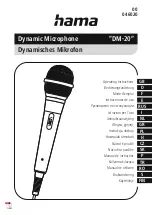
26
8. Connection
a) Connecting the Receiver
For output connections always use the appropriate shielded XLR or cinch cables. Other unsui-
table cables may lead to malfunctioning.
To avoid distortions or false adjustments that may damage the device, only connect devices
with an XLR input to the XLR output, or devices with a cinch input to the cinch output.
• Switch the receiver off. The POWER switch (2) must not be pressed, the indicator in the switch must not
light up.
• Switch off the audio device (mixing desk or other) to which the receiver will be connected and discon-
nect it from the mains.
• Connect the audio input of the audio device with one of the receiver’s audio outputs.
When the signals of both transmitters are transmitted separately, connect the MIC-A (12) and MIC-B (11)
connections to two audio device inputs (e.g. mixer).
When the signals of both transmitters are transmitted together, connect the MIXED A/B connection (10)
to the input of an audio device.
• Insert the aerials supplied into the receiver’s ANT A (1) and ANT.B (9) connections and fasten them by
tightening the cap nuts. Now align the surface exactly vertically.
b) Mains Connection
The mains outlet to which the power unit is connected must be easily accessible so that the
power unit can be separated from the mains voltage quickly in case of an error.
Do not let the mains cable come into contact with any other cables.
Be careful when handling the mains cables and mains connection. Mains voltage can lead to a
fatal electric shock.
Make sure that no cables lie open. Install cables professionally to prevent accidents.
Ensure that the receiver is switched off (the POWER switch (2) must not be pressed), before
connecting it to the power supply.
• Connect the power unit connection line to the receiver’s DC IN (13) socket.
• Plug the power supply into the wall socket.
• The receiver is turned on and off at the POWER (2) switch.
Switch depressed: Device on, switch not depressed: Device off
















































